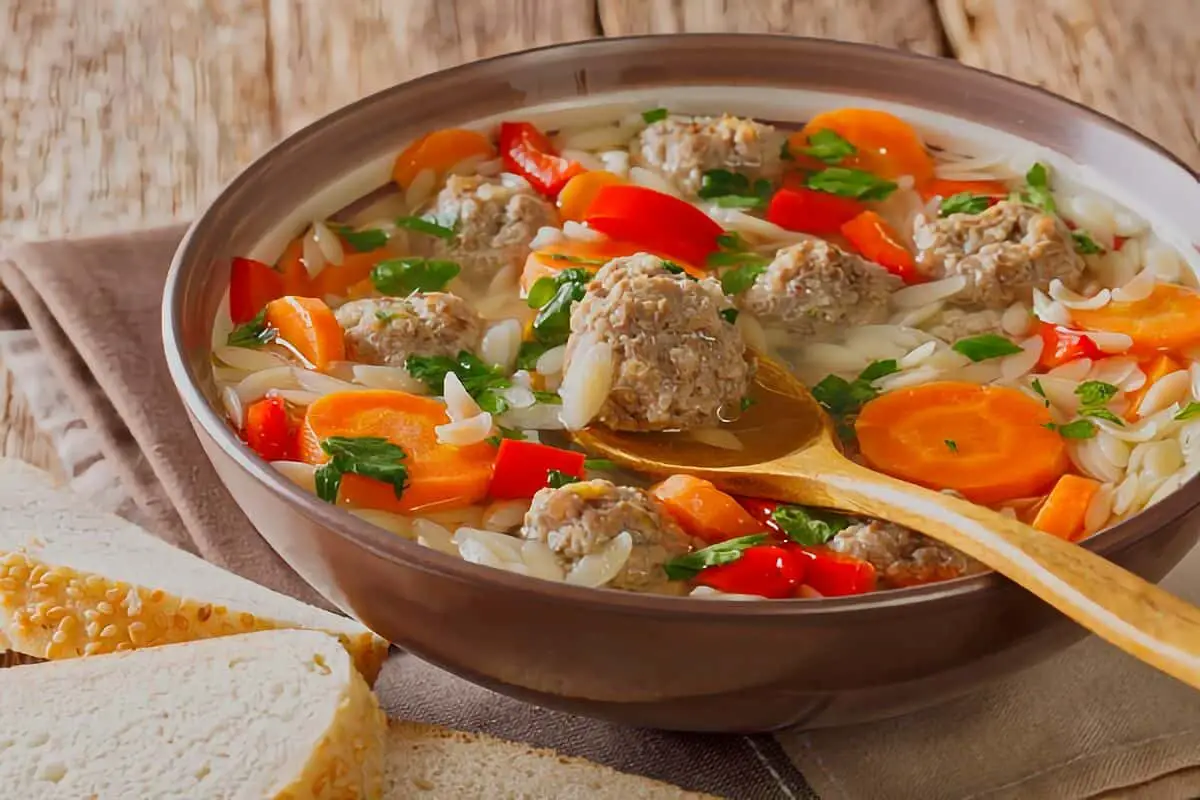The Guatemalan Sopa de Albóndigas recipe was the best part of my cooking class in Mixco. This town, which is just outside Guatemala City, is famous for its rich cultural history and lively local community. Mixco has a lot of interesting places to see, like the amazing Mixco Viejo archaeological site, where people can check out ancient Mayan ruins. The busy markets and local restaurants make the town charming, making it a fun place to visit.
In the cooking class, we worked on making Sopa de Albóndigas, a traditional meatball soup that is well-known in Guatemalan cuisine. This dish is commonly enjoyed at family gatherings and special events, highlighting its significance in local culture. While we collected the ingredients, I made sure to remember the main parts of the recipe, like ground beef, rice, vegetables, and a tasty broth. First, we started by making the meatballs. This meant combining the ground beef with rice and some spices.
I had a good first impression of the Guatemalan Sopa de Albóndigas recipe. The ingredients mixed nicely, and it was easy to shape the meatballs. After getting ready, the meatballs were carefully put into a pot of hot broth made from water, tomatoes, and spices. The mix of flavors was key to making the soup’s unique taste.
While the soup cooked, we cut up vegetables like carrots, zucchini, and cilantro to make the dish fresh and colorful. The bright colors of the vegetables looked great against the dark broth. After a while, the meatballs were fully cooked, and the kitchen smelled really good. We were really excited to taste the final dish as we got ready to serve it.
When I finally got to try the Guatemalan Sopa de Albóndigas, I noticed that the texture was both hearty and light. The meatballs were soft and tasty, paired nicely with the fresh vegetables. The broth was flavorful and tasty, with the perfect amount of spices. Every spoonful was enjoyable, showing why people in the area love this recipe so much.
Sopa de Albóndigas is very popular in Mixco, and you can often find it in local restaurants and homes. This dish is a common part of family meals, and a lot of people enjoy how comforting it is. Families often come together around the table to enjoy this soup, showing how important it is in their culture.
After the cooking class, I spent some time checking out Mixco. The town has different parks and plazas where people often come together to hang out. Going to the markets let me check out local sellers with fresh fruits and vegetables, as well as handmade items. The feeling of community in Mixco is clear, and it makes the experience of enjoying traditional foods like Guatemalan Sopa de Albóndigas even better.
In conclusion, my trip to Mixco and the cooking class about the Guatemalan Sopa de Albóndigas recipe gave me important insights into the local food. The way the dish was made was easy, and the flavors were really great. Sopa de Albóndigas is really important to many Guatemalans, and I learned to appreciate how it fits into their culture. This experience showed how important food is for bringing people together, and I can’t wait to share this recipe with others.
Ingredients For the Guatemalan Sopa de Albóndigas Recipe
Ground Beef
Uncooked Rice
Finely Chopped Onion
Finely Chopped Fresh Cilantro
Minced Cloves Garlic
Ground Cumin
Dried Oregano
Salt
Black Pepper
Beef or Vegetable Broth
Peeled and Diced Medium Carrots
Peeled and Diced Medium Potatoes
Frozen Peas
Chopped Tomatoes
Tomato Paste
Vegetable Oil
Lime Juice
Fresh Cilantro Leaves
Cooking Instructions For the Guatemalan Sopa de Albóndigas Recipe
In a large mixing bowl, combine 1 pound of ground beef, 1/2 cup of uncooked rice, 1/4 cup of finely chopped onion, 1/4 cup of finely chopped fresh cilantro, 2 cloves of minced garlic, 1 teaspoon of ground cumin, 1/2 teaspoon of dried oregano, 1/2 teaspoon of salt, and 1/4 teaspoon of black pepper. Mix well until all ingredients are evenly incorporated. – Thoroughly mix the ground beef and rice together to ensure a consistent texture in the meatballs. Finely chop the onion and cilantro to enhance their flavors in the meatballs. The garlic adds a fragrant aroma and taste to the meatball mixture. Ground cumin and dried oregano provide a warm and earthy spice profile to the meatballs. Salt and black pepper help to season the meatball mixture for optimal taste.
Shape the meatball mixture into small, bite-sized balls, approximately 1 inch in diameter. Set them aside on a plate or baking sheet. – Roll the meatball mixture between your palms to form uniform-sized balls. Ensure that each meatball is compact and holds its shape. Place the shaped meatballs on a plate or baking sheet to keep them organized. Make the meatballs small to ensure they cook evenly and fit well in the soup. Creating bite-sized meatballs allows for easy consumption and even distribution in the soup.
In a large pot, heat 1 tablespoon of vegetable oil over medium heat. Add the chopped tomatoes and cook for 2-3 minutes, until they start to soften. – Heat the vegetable oil until it becomes hot and shimmering. Add the chopped tomatoes to the pot to enhance the soup’s flavor and texture. Cook the tomatoes until they become tender and release their juices. Stir the tomatoes occasionally to prevent sticking and ensure even cooking. Softened tomatoes will add a delicious tanginess to the soup.
Pour in 8 cups of beef or vegetable broth and bring it to a boil. Once boiling, reduce the heat to low and let it simmer for 10 minutes to allow the flavors to meld. – Choose either beef or vegetable broth based on your preference or dietary restrictions. Pour the broth into the pot to create the soup’s base and provide depth of flavor. Bring the broth to a rolling boil to ensure all ingredients cook thoroughly. Lower the heat to prevent the broth from boiling over and simmer for 10 minutes. Simmering allows the flavors to infuse the broth, resulting in a richer taste.
Add the sliced carrots, diced potatoes, frozen peas, and 1 tablespoon of tomato paste to the pot. Stir well and continue to simmer for an additional 10-15 minutes until the vegetables are tender. – Slice the carrots into thin rounds for quick cooking and easy eating. Dice the potatoes into small cubes to ensure they cook evenly and soften. Add the frozen peas to the pot to provide vibrant color and a burst of freshness. Incorporate the tomato paste to enhance the soup’s flavor and deepen its color. Stir the mixture regularly to prevent sticking and ensure even cooking of the vegetables.
Gently drop the prepared meatballs into the simmering soup. Cover the pot and cook for 15-20 minutes, or until the meatballs are cooked through. – Carefully place the meatballs into the soup to avoid splashing or breaking them. Ensure the meatballs are fully submerged in the soup for even cooking. Cover the pot to trap heat and moisture, allowing the meatballs to cook thoroughly. Cook the meatballs until they are no longer pink in the center and reach a safe internal temperature. Test one meatball for doneness by cutting it open to ensure it is cooked through.
Optional: Stir in 1 tablespoon of lime juice to add a refreshing citrus note to the soup. Adjust the seasoning with salt and pepper if desired. – Squeeze fresh lime juice into the soup for a tangy and bright flavor. Lime juice adds a zesty element that complements the other flavors in the soup. Taste the soup and add more salt and pepper if needed to enhance the overall seasoning. Adjust the seasoning gradually, tasting after each addition to avoid overseasoning. Salt and pepper allow you to customize the soup’s taste to your preference.
Serve the Guatemalan Sopa de Albóndigas hot, garnished with fresh cilantro leaves if desired. – Ladle the hot soup into bowls for serving. Ensure each bowl contains a generous portion of meatballs and vegetables. Sprinkle fresh cilantro leaves on top of the soup for added aroma and visual appeal. The cilantro garnish adds a pop of color and freshness to the dish. Enjoy the Guatemalan Sopa de Albóndigas while it’s still hot for the best flavor experience.
Most Popular Spices Used by Guatemalan Locals
Guatemalan cuisine is known for its balanced and flavorful use of spices, combining native ingredients with those introduced by Spanish settlers to create a rich tapestry of taste. One of the most prominent spices in Guatemalan cooking is Qchiote (annatto), which adds a mild peppery flavor and vibrant red hue to various dishes. Often ground into a paste, achiote is used in stews, tamales, and rice, infusing the food with an earthy flavor that complements other ingredients. Its coloring properties also enhance the visual appeal of traditional recipes, making it a versatile favorite among locals.
Another essential spice is Pepitoria, or ground pumpkin seeds. Unique to Guatemalan and neighboring Central American cuisines, pepitoria is often used to thicken sauces and add depth to stews, especially in dishes like pepian, where it contributes a subtle nutty flavor. Combined with roasted tomatoes, chilies, and other spices, pepitoria adds a distinctive richness that embodies the essence of Guatemalan cooking. This practice of using seeds as a seasoning reflects ancient Mayan cooking traditions, which continue to influence modern Guatemalan flavors.
Cinnamon is also widely used, particularly in sweet and savory dishes that highlight Guatemalan cuisine’s Spanish influence. Known locally as canela, cinnamon is a common ingredient in mole sauces, as well as in desserts and beverages like atol de elote (a corn-based drink). Its warm, aromatic flavor adds complexity to various recipes, bridging the flavors of local ingredients with a Spanish touch. Often paired with other spices, cinnamon is essential in creating the nuanced flavors found in Guatemalan comfort foods.
Allspice is another popular spice in Guatemala, bringing a warm, slightly peppery note to savory dishes and marinades. This spice, derived from the dried berries of the pimento tree, is known as *pimienta gorda* in Guatemala and is commonly used in soups, stews, and meats. Its subtle complexity enhances dishes without overpowering them, offering a rounded flavor profile that highlights the country’s love for balanced seasoning.
Chili Peppers such as cobán and guajillo varieties are staples for adding heat and depth. Though Guatemalan cuisine is not typically very spicy, the addition of these chilies gives dishes a gentle warmth and smokiness. Ground or used whole, these chilies appear in everything from salsas to stews, like the renowned kak’ik, a spicy turkey soup from the highlands. Together, these spices — achiote, pepitoria, cinnamon, allspice, and chili peppers — define the flavors of Guatemalan food, infusing it with tradition and the unique balance of local and global influences.
Eating Healthy in Guatemala
Paragraph From
Eating healthy in Guatemala is achievable, thanks to the country’s abundant fresh produce, local markets, and traditional cooking methods that prioritize natural ingredients. Guatemala’s varied landscape, which includes fertile highlands and tropical lowlands, allows for a diverse range of fruits, vegetables, and grains. Staples like black beans, corn, and rice form the base of many dishes and offer a nutritious source of protein, fiber, and essential vitamins. Black beans, in particular, are a common ingredient in Guatemalan meals, providing protein and fiber without saturated fats, making them a great choice for a balanced diet. Paired with corn tortillas — a daily staple rich in fiber and antioxidants — these ingredients are satisfying and help maintain energy levels throughout the day.
One of the most beneficial aspects of Guatemalan cuisine is its emphasis on fresh vegetables and fruits. Local markets, or mercados, are filled with seasonal produce such as tomatoes, avocados, carrots, and leafy greens. Vegetables are often incorporated into traditional dishes like caldo de res, a hearty beef soup loaded with nutrient-dense vegetables, or jocon, a chicken stew made with tomatillos and cilantro. The vibrant colors in these dishes reflect the high vitamin and antioxidant content that supports overall health, making it easy to get essential nutrients through regular meals.
In addition to vegetables, tropical fruits such as papaya, mango, and bananas are commonly available, offering essential vitamins like vitamin C and potassium. These fruits are often enjoyed fresh, juiced, or as a light snack, providing natural sugars and hydration in the country’s warmer regions. The emphasis on fresh, whole foods is also reflected in Guatemalan drinks, where fruit-based beverages and traditional teas are common, reducing the need for processed, sugar-laden options.
Guatemalan cooking methods also support a healthier diet. Many dishes are simmered, boiled, or lightly sautéed rather than fried, preserving the nutritional value of ingredients without adding unnecessary fats. Traditional stews, like pepian and hilachas, are slow-cooked with minimal oil, allowing spices, herbs, and vegetables to enhance the flavor naturally. This approach not only brings out the authentic flavors of the ingredients but also aligns with the principles of healthy eating by reducing added fats and sugars.
Overall, Guatemala’s local markets, traditional foods, and natural cooking techniques make it easy to eat healthily. Embracing these customs allows individuals to enjoy a balanced, nutrient-rich diet rooted in fresh, wholesome ingredients, supporting wellness and long-term health.
 FAQ For the Guatemalan Sopa de Albóndigas Recipe
FAQ For the Guatemalan Sopa de Albóndigas Recipe
Q: What ingredients do I need for the Guatemalan Sopa de Albóndigas recipe?
A: To make the Guatemalan Sopa de Albóndigas recipe, you will need a variety of ingredients that create a hearty and flavorful soup. The main components include ground meat, usually beef or pork, which is seasoned with spices and formed into meatballs. Additionally, you will require vegetables such as carrots, potatoes, and zucchini, which add nutrition and texture to the dish. Broth, typically chicken or beef, serves as the base for the soup, while herbs like cilantro and spices enhance the flavor profile. Don’t forget to include rice or corn for an authentic touch.
Q: How do I prepare the Guatemalan Sopa de Albóndigas recipe?
A: Preparing the Guatemalan Sopa de Albóndigas recipe involves several steps to ensure a delicious final dish. Begin by mixing the ground meat with spices, forming small meatballs, and then browning them in a pot. Next, remove the meatballs and sauté chopped onions, garlic, and other vegetables until softened. After that, add the broth, bring it to a boil, and gently return the meatballs to the pot. Let the soup simmer until the meatballs are cooked through and the vegetables are tender. Finally, season to taste and serve hot, garnished with fresh herbs.
Q: Can I customize the Guatemalan Sopa de Albóndigas recipe?
A: Yes, you can easily customize the Guatemalan Sopa de Albóndigas recipe to suit your preferences and dietary needs. For instance, if you prefer a vegetarian version, you can substitute the meatballs with plant-based alternatives or skip them entirely. You can also vary the types of vegetables used, incorporating seasonal options or those you have on hand. Additionally, experimenting with spices or adding different herbs can create unique flavor profiles, making the soup your own while still retaining the essence of the traditional recipe.
Q: How long does it take to cook the Guatemalan Sopa de Albóndigas recipe?
A: The cooking time for the Guatemalan Sopa de Albóndigas recipe is relatively quick, making it an ideal choice for a weeknight meal. Once you have prepared the ingredients and formed the meatballs, browning them typically takes about 5 to 7 minutes. After sautéing the vegetables and adding the broth, the soup will need to simmer for approximately 20 to 30 minutes until the meatballs are fully cooked and the vegetables are tender. In total, you can expect the entire process, including preparation, to take around 45 to 60 minutes.
Q: What can I serve with the Guatemalan Sopa de Albóndigas recipe?
A: The Guatemalan Sopa de Albóndigas recipe is a hearty dish that can be served with various accompaniments to enhance your meal. A side of warm corn tortillas or crusty bread pairs well, allowing you to soak up the flavorful broth. Additionally, you might consider serving a simple salad to balance the richness of the soup. For added flavor, a squeeze of lime or a sprinkle of fresh cilantro on top just before serving can elevate the dish, making for a satisfying and well-rounded dining experience.

Guatemalan Sopa de Albóndigas Recipe
Equipment
- Large mixing bowl: Used to combine the ground beef, rice, onion, cilantro, garlic, and spices for the meatballs.
- Plate or baking sheet: Used to place the shaped meatballs before cooking.
- Large pot: Used to cook the soup and simmer the ingredients.
- Stirring spoon: Used to stir the soup and ensure even cooking.
- Knife: Used for chopping onions, cilantro, and tomatoes.
- Cutting board: Used for chopping vegetables and herbs.
- Ladle: Used to serve the soup into bowls.
- Soup bowls: Used to serve the Guatemalan Sopa de Albóndigas.
Ingredients
- 1 pound ground beef
- 1/2 cup rice uncooked
- 1/4 cup onion finely chopped
- 1/4 cup fresh cilantro finely chopped
- 2 cloves garlic minced
- 1 teaspoon cumin ground
- 1/2 teaspoon oregano dried
- 1/2 teaspoon salt
- 1/4 teaspoon black pepper
- 8 cups beef or vegetable broth
- 2 carrots medium - peeled and sliced
- 2 potatoes medium - peeled and diced
- 1 cup peas frozen
- 1 cup chopped tomatoes
- 1 tablespoon tomato paste
- 1 tablespoon vegetable oil
- 1 tablespoon lime juice optional
- Fresh cilantro leaves for garnish optional
Instructions
In a large mixing bowl, combine 1 pound of ground beef, and ingedients
- a. Thoroughly mix the ground beef and rice together to ensure a consistent texture in the meatballs.
- b. Finely chop the onion and cilantro to enhance their flavors in the meatballs.
- c. The garlic adds a fragrant aroma and taste to the meatball mixture.
- d. Ground cumin and dried oregano provide a warm and earthy spice profile to the meatballs.
- e. Salt and black pepper help to season the meatball mixture for optimal taste.
Shape the meatball mixture into small, bite-sized balls, approximately 1 inch in diameter. Set them aside on a plate or baking sheet.
- a. Roll the meatball mixture between your palms to form uniform-sized balls.
- b. Ensure that each meatball is compact and holds its shape.
- c. Place the shaped meatballs on a plate or baking sheet to keep them organized.
- d. Make the meatballs small to ensure they cook evenly and fit well in the soup.
- e. Creating bite-sized meatballs allows for easy consumption and even distribution in the soup.
In a large pot, heat 1 tablespoon of vegetable oil over medium heat. Add the chopped tomatoes and cook for 2-3 minutes, until they start to soften.
- a. Heat the vegetable oil until it becomes hot and shimmering.
- b. Add the chopped tomatoes to the pot to enhance the soup's flavor and texture.
- c. Cook the tomatoes until they become tender and release their juices.
- d. Stir the tomatoes occasionally to prevent sticking and ensure even cooking.
- e. Softened tomatoes will add a delicious tanginess to the soup.
Pour in 8 cups of beef or vegetable broth and bring it to a boil. Once boiling, reduce the heat to low and let it simmer for 10 minutes to allow the flavors to meld.
- a. Choose either beef or vegetable broth based on your preference or dietary restrictions.
- b. Pour the broth into the pot to create the soup's base and provide depth of flavor.
- c. Bring the broth to a rolling boil to ensure all ingredients cook thoroughly.
- d. Lower the heat to prevent the broth from boiling over and simmer for 10 minutes.
- e. Simmering allows the flavors to infuse the broth, resulting in a richer taste.
Add the sliced carrots, diced potatoes, frozen peas, and 1 tablespoon of tomato paste to the pot. Stir well and continue to simmer for an additional 10-15 minutes until the vegetables are tender.
- a. Slice the carrots into thin rounds for quick cooking and easy eating.
- b. Dice the potatoes into small cubes to ensure they cook evenly and soften.
- c. Add the frozen peas to the pot to provide vibrant color and a burst of freshness.
- d. Incorporate the tomato paste to enhance the soup's flavor and deepen its color.
- e. Stir the mixture regularly to prevent sticking and ensure even cooking of the vegetables.
Gently drop the prepared meatballs into the simmering soup. Cover the pot and cook for 15-20 minutes, or until the meatballs are cooked through.
- a. Carefully place the meatballs into the soup to avoid splashing or breaking them.
- b. Ensure the meatballs are fully submerged in the soup for even cooking.
- c. Cover the pot to trap heat and moisture, allowing the meatballs to cook thoroughly.
- d. Cook the meatballs until they are no longer pink in the center and reach a safe internal temperature.
- e. Test one meatball for doneness by cutting it open to ensure it is cooked through.
Optional: Stir in 1 tablespoon of lime juice to add a refreshing citrus note to the soup. Adjust the seasoning with salt and pepper if desired.
- a. Squeeze fresh lime juice into the soup for a tangy and bright flavor.
- b. Lime juice adds a zesty element that complements the other flavors in the soup.
- c. Taste the soup and add more salt and pepper if needed to enhance the overall seasoning.
- d. Adjust the seasoning gradually, tasting after each addition to avoid overseasoning.
- e. Salt and pepper allow you to customize the soup's taste to your preference.
Serve the Guatemalan Sopa de Albóndigas hot, garnished with fresh cilantro leaves if desired.
- a. Ladle the hot soup into bowls for serving.
- b. Ensure each bowl contains a generous portion of meatballs and vegetables.
- c. Sprinkle fresh cilantro leaves on top of the soup for added aroma and visual appeal.
- d. The cilantro garnish adds a pop of color and freshness to the dish.
- e. Enjoy the Guatemalan Sopa de Albóndigas while it's still hot for the best flavor experience.
Notes
cooking process. Use a sharp knife for efficient and precise vegetable chopping. Make extra meatballs and freeze them for future use. Customize the soup by adding additional vegetables or herbs for more flavor. Squeeze some fresh lime juice over the soup before serving for a citrusy kick.




3 comments
The meatballs in this soup were tender, and the broth was flavorful.
I cant believe they didnt mention the secret ingredient in the Guatemalan Sopa de Albóndigas recipe! Its what makes it truly authentic. Cant spill the beans here though, gotta keep the mystery alive!
I cant believe they didnt mention the secret ingredient for the Guatemalan Sopa de Albóndigas recipe! Everyone knows its the key to making it authentic. What a missed opportunity!